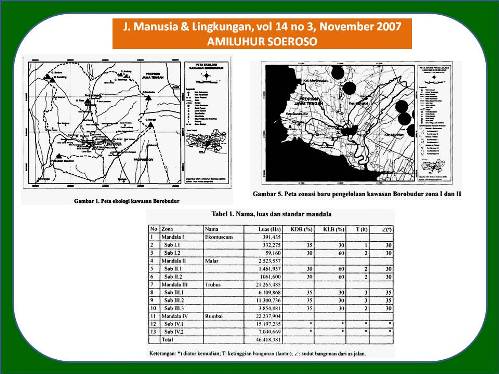
KONSERVASI SAUJANA BUDAYA KAWASAN BOROBUDUR - ZONASI ULANG DENGAN PENDEKATAN EKOSISTEM (Conservation of the Borobudur Cultural Landscape: Rezoning of area Management by Ecosystem Approach)
Amiluhur Soeroso(1*)
(1) Fakultas Ekonorni, Universitas Atmajaya, Babarsari Yogyakarta 55281
(*) Corresponding Author
Abstract
ABSTRAK
Dalam banyak aspek, nilai saujana budaya Borubudur memiliki arti penting bagi masyarakat yang hidup di sekitamya. Namun demikian, sejak selesainya proyek restorasi, dan kemudian Candi Borobudur dijadikan sebagai pus aka dunia pada tabun 1991, saujana budayanya menghadapi berbagai konftik kepentingan yang disebabkan oleh ketidak-tepatan zonasi lama (karena hanya berorientasi kepada candi, monumen atau artifak sehingga menafikan ekosistem) dan pengelolaan yang dilakukan oleh banyak institusi. Masalah ini mengakibatkan risiko degradasi kualitas saujana budaya (polusi fisik, visual dan kebudayaan) yang berpengaruh terhadap eksistensi situs Borobudur di masa depan. Berkaitan dengan kelangkaan sumberdaya lingkungan yang dimilikinya, dibutuhkan studi mendalam dengan fokus mengkonsolidasikan dan melindungi integritas saujana budaya tersebut. Data zonasi ulang dengan tujuan untuk pengelolaan dilakukan dengan menampalkan peta-peta tematik berdasarkan pendekatan ekosistem. Hasilnya adalah: (1) zonasi konservasi Kawasan Borobudur dialokasikan menjadi empat bagi!ln (Mandala), (2) pentingnya konservasi pusaka sebaiknya dikomunikasikan melalui sarana pendidikan terhadap para pengguna dan menempatkan masyarakat di sekitamya sebagai titik penting dalam pengelolaan kawasan Borobudur. Dengan demikian, kelestarian Borobudur di masa depan tergantung pada kebijakan pembangunan yang berkelanjutan. Manajemen Kawasan Borobudur tidak dapat hanya fokus pada situs, material atau artifak semata tetap harus bergeser untuk memperhatikan ruang dan kawasan tempat manusia hidup.
ABSTRACT
The Borobudur cultural landscape values have conferred important meanings in many aspects for those who live in its surrounding neighborhood. Nevertheless, since the beginning of Borobudur restoration project and the acknowledgement of Borobudur Temple as the world's heritage in 1991, its cultural landscape is continually facing out of the ordinary kinds of conflicts caused by unappropriate old zoning area (because just oriented to the temple, monument or artifact so that neglected its ecosystem) and the taking part of many authorities in managing Borobudur area. This issue brings a serious concern on the risk of degrading quality of cultural landscape (pollution of physical, visual and cultural) which affecting the future existence of Borobudur’s site. Recognized to the scarcity nature of environmental resources, a widespread research on such area is required and should be conducted with focus on consolidating and protecting the integrity of its cultural landscape. Data of rezoning area were obtained from thematic maps and after that being super imposed basically on ecosystem approach. Its product is zone of management. The results indicate that: (1) the zoning allocation of Borobudur conservation area is specified in four parts called ‘ekomuseum’ (ecomuseum), ‘malar’ (continues), ‘trubus’ (growth) and ‘rumbai’ (fringe), (2) the importance of heritage conservation should be communicated by means of educating the users and putting the surrounding society as the focal point in managing Borobudur area. For the reason, the survival of Borobudur’s site in the future will fully depend on its sustainable development policy to those products. Management of Borobudur should have not to focus on sites, material or artifacts and shifting to space or area where human being living.
Full Text:
Artikel lengkap (PDF) (Bahasa Indonesia)Article Metrics
Refbacks
- There are currently no refbacks.
Copyright (c) 2017 Jurnal Manusia dan Lingkungan







